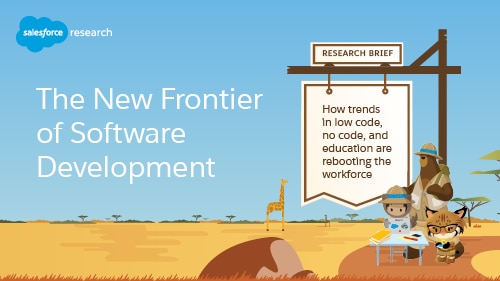The secret to change — at least according to Socrates — is to focus all of your energy not on fighting the old, but on building the new. This sentiment has never been more relevant for IT leaders than it is today.
In this Fourth Industrial Revolution, we’re sprinting into an era when tech innovation seemingly happens overnight. Does this pace create unprecedented challenges for the developer community? Sure. But does it also create opportunities that we wouldn’t have dreamed of a decade ago? Resoundingly, yes.
The new Salesforce Research brief, “The New Frontier of Software Development,” is a data-driven overview of how low code, no code, and educational platforms are empowering the workforce. You can download the brief for a deeper analysis, along with detailed research. Here are a few highlights that stuck out for me.
IT organizations face growing demands and shrinking talent pools.
The expectation to “do more with less (and faster)” is a stark reality. As industry analyst Michael Krigsman points out, IT now is not just an enabler of efficiency, but also an enabler of innovation. A survey of IT leaders revealed that their top two challenges are innovating for the business and project speed. The battle between innovating and keeping the lights on is nothing new for IT leaders — yet business’ appetite for better, more differentiated capabilities grows stronger by the minute.
Why? The reality is that everyone has sky-high expectations for cutting-edge experiences — everywhere you look. Eighty percent of business buyers expect companies to interact with them in real time. Seventy-nine percent of millennial consumers expect that smart home technology will impact their daily lives by 2020. Even employees want digital experiences that are as easy and connected as the most beloved consumer brands. As business users’ expectations change, the role of the developer continues to shift. Today, developer success is measured by user adoption and loyalty. Developers must build apps that customers love.
This only compounds an already difficult issue at the intersection of supply, demand, and know-how. While companies need a steady stream of highly skilled developers to meet these changing expectations — and remain competitive — the supply falls well short of demand.

What’s more, many lack skills in key technologies such as artificial intelligence (AI), the Internet of Things (IoT), and mobile applications that underpin these expectations. By some estimates, in 2017, there were fewer than 50,000 computer science graduates to fill 500,000 open developer jobs in the U.S. alone.
More companies are opening doors for citizen development.
To bridge workforce skill gaps, more and more companies are exploring citizen development — empowering end users to create comparably simple business applications under IT governance. We like to call this a “clicks not code” approach — meaning it takes advantage of low-code or no-code development.
The benefits are twofold. First, developers can hand off some lower-priority projects that often clog up their pipelines, enabling them to focus on innovating. Second, it turns would-be requesters from other business units into self-motivated doers. These citizen developers now have the means to build what they want, the way they want it, instead of waiting in an IT request queue. And as a bonus, it often leads to really creative solutions, like the citizen development story detailed in this interview.

New educational approaches can expand the developer workforce.
“Never stop learning” has always been a mantra of mine — but now more than ever. We’re at this incredible point in time when we’re having open, constructive conversations about the inequalities in tech. One research study found that only 26% of IT organizations believe they’re excellent at workforce diversity and inclusion. Another estimates that only one in five software developers in the U.S. is female.
What excites me about low-code and no-code development is the ability to remove or reduce the barrier to entry. It essentially lays out a welcome mat to everyone that says, “You don’t have to know it all — you just have to want to learn.” It democratizes education for in-demand technical skills. Education must be accessible to all in order to create a truly inclusive and diverse workforce.
The last point to highlight about learning is that it’s not just about new recruits — it’s also about leadership. If a company is to take continuous learning to heart, it often means reskilling or upskilling those already in their ranks.

Business leaders should reach far and wide to ensure they have a culture that celebrates learning, and that provides equal access to learning. The more we can do that, the more we’ll make progress on bridging skill gaps.
For an in-depth look at the factors transforming development today, check out the full report: “The New Frontier of Software Development.”





























